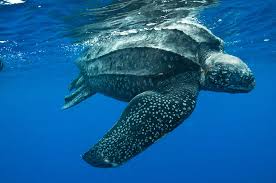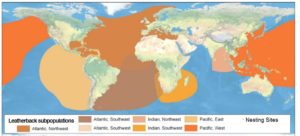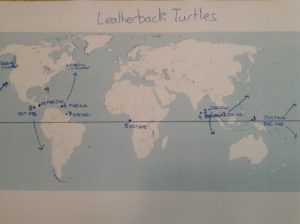Leatherback Turtles can be found nesting on tropical beaches and foraging for food over a wide area of the worlds oceans. Their numbers have dropped to about 40 000 nesting females world wide and can be seen in the areas below.



1 West Papua, Birds Head Peninsular. Nesting JULY - AUG for Northern Pacific turtles and DEC-MAR for southern pacific turtles.Jamursba Medi and Wermon beaches in the Bird’s Head Seascape of West Papua host the largest remaining nesting aggregation of leatherback turtles in the Pacific.
2. NO LONGER VIABLE.Rantau Abang in Terengganu, Malaysia, once had the largest nesting population in the world, hosting 10,000 nests per year. The major cause for the decline was egg consumption by humans.JUN-AUG
3. Andaman Islands DEC-JAN.
4. Sri Lanka DEC-JAN
5. Gabon.The beaches of Mayumba National Park in Mayumba, Gabon, host the largest nesting population on the African continent and possibly worldwide, with nearly 30,000 turtles visiting its beaches each year between October and April.
6. Trinidad. APR-AUG.
7 Guyana, French Guiana , Suriname The Galibi Nature Reserve is only accessible by a 90 minute boat ride from Albina. The best time to view giant Leatherback turtles is from April to August. The turtles generally nest from April to July and their eggs hatch from July to August.
8. Playa Grande Costa Rica. OCT-FEB
9. Costa Rica, the beaches of Gandoca and Parismina provide nesting grounds. MAR-JULY
10. Colombia April to August.
11. Some turtles nest on the east coast of Florida. MAR- AUG.
Pacific subpopulation.
Pacific leatherbacks divide into two populations. One population nests on beaches in Papua, Indonesia, and the Solomon Islands, and forages across the Pacific in the Northern Hemisphere, along the coasts of California, Oregon, and Washington in North America. The eastern Pacific population forages in the Southern Hemisphere, in waters along the western coast of South America, nesting in Mexico, Panama, El Salvador, Nicaragua, and Costa Rica.
The continental United States offers two major Pacific leatherback feeding areas. One well-studied area is just off the northwestern coast near the mouth of the Columbia River. The other American area is located in California. Further north, off the Pacific coast of Canada, leatherbacks visit the beaches of British Columbia.
Estimates by the WWF suggest only 2,300 adult females of the Pacific leatherback remain, making it the most endangered marine turtle subpopulation.
Atlantic subpopulation.
The leatherback turtle population in the Atlantic Ocean ranges across the entire region. They range as far north as the North Sea and to the Cape of Good Hope in the south. Unlike other sea turtles, leatherback feeding areas are in colder waters, where an abundance of their jellyfish prey is found, which broadens their range. However, only a few beaches on both sides of the Atlantic provide nesting sites.
Off the Atlantic coast of Canada, leatherback turtles feed in the Gulf of Saint Lawrence near Quebec and as far north as Newfoundland and Labrador. The most significant Atlantic nesting sites are in SurinameThe Galibi Nature Reserve is only accessible by a 90 minute boat ride from Albina. The best time to view giant Leatherback turtles is from April to August. The turtles generally nest from April to July and their eggs hatch from July to August., Guyana, French Guiana in South America, Antigua and Barbuda, and Trinidad and Tobago in the Caribbean, and Gabon in Central Africa. The beaches of Mayumba National Park in Mayumba, Gabon, host the largest nesting population on the African continent and possibly worldwide, with nearly 30,000 turtles visiting its beaches each year between October and April. Off the northeastern coast of the South American continent, a few select beaches between French Guiana and Suriname are primary nesting sites of several species of sea turtles, the majority being leatherbacks. A few hundred nest annually on the eastern coast of Florida.In Costa Rica, the beaches of Gandoca and Parismina provide nesting grounds.
